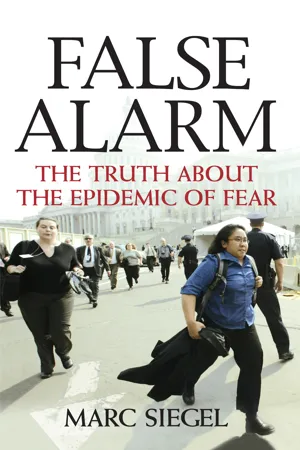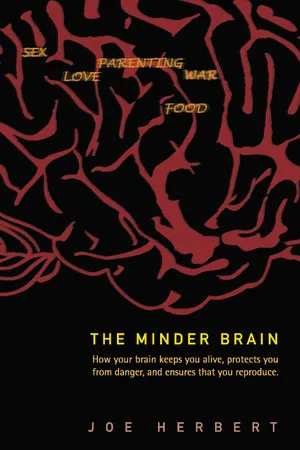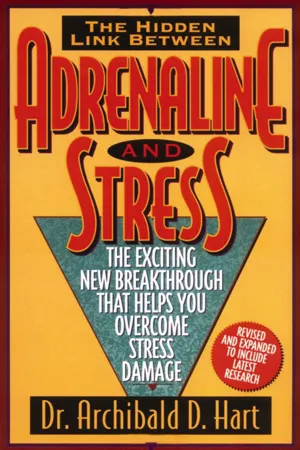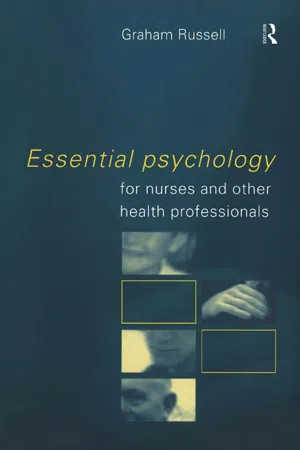Psychology
Fight-or-Flight Response and The Role of Adrenaline
The fight-or-flight response is a physiological reaction that occurs in response to a perceived threat, preparing the body to either confront or flee from the danger. Adrenaline, also known as epinephrine, is a hormone released during this response, increasing heart rate, dilating airways, and redirecting blood flow to muscles, enabling the body to respond quickly to the threat.
Written by Perlego with AI-assistance
Related key terms
Related key terms
1 of 4
Related key terms
1 of 3
12 Key excerpts on "Fight-or-Flight Response and The Role of Adrenaline"
- eBook - ePub
The Body Bears the Burden
Trauma, Dissociation, and Disease
- Robert Scaer(Author)
- 2014(Publication Date)
- Routledge(Publisher)
The immediate effects of the arousal neurotransmitter norepinephrine on the brain include increased alertness and focus, immediate enhancement of short-term memory, dilatated pupils, increased muscle tone, and divergence (outward movement) of the eyes to expand the field of view. The immediate effects of body-based epinephrine and brain-based norepinephrine prepare the organism for the high-level neuromuscular activity required for ensuring survival in the face of threat—the fight/flight response. These effects promote short-term preparation of the brain for intense alertness, and the neuromuscular and cardiovascular systems for high-level short-term skeletal muscle and cardiac activity and energy expenditure. Activation of the fight/flight response, of course, may be triggered by excitement as well as by threat.FIGURE 2.2 Hypothalamic/pituitary/adrenal axis. Sensory input signaling stress or threat (see Figure 2.1 ) activates the hypothalamus, triggering release of corticotropin-releasing hormone (CRH) and arginine vasopressin (AVP). These promote release of cortisol from the adrenal medulla. Cortisol inhibits further release of ACTH, modulates the basic noradrenergic arousal response, and mediates the long-term stress adaptation response to stress.The basic physiological sympathetic nervous system response of the prey in response to threat is mirrored by that of the predator as it prepares for attack. Pre-game jitters, stage fright, sexual arousal, and the thrill of the roller coaster ride all reflect the physical sensations associated with arousal in the face of threat. What separates the experience of the fight/flight response from that of anticipatory excitement, of course, is the meaning of the event to the participant. This piece of information processing takes place in the hippocampus (comparison of new information with past associative memories), and the orbitofrontal cortex (problem solving and planning).4 - eBook - ePub
- Paul McGreevy, Janne Winther Christensen, Uta König von Borstel, Andrew McLean(Authors)
- 2018(Publication Date)
- Wiley-Blackwell(Publisher)
Figure 13.1 The standard stress model. When the brain perceives a stressor, two main sets of physiological reactions prepare the body for bursts of exercise (‘fight or flight’) and activate a range of other reactions (e.g. reduced pain perception and immunological responses).The central nervous system assesses whether a stimulus represents a significant challenge to the animal. If it is perceived as threatening (i.e. a stressor), the biological defence consists of a combination of behavioural, autonomic and neuroendocrine stress reactions, and the individual is in a state of stress. The body’s immediate physiological reaction to a stressor is characterised by activation of the sympathetic system, which prepares the body for action. The fight or flight reaction of the sympathetic system is initiated by stimulation of the hypothalamus, which transmits signals via the reticular formation in the brain stem to the spinal cord to cause sympathetic discharge. This immediately results in several physiological changes, which lead to a greater physical and mental ability, so that the animal can perform more strenuous physical activity than would otherwise be possible (Korte, 2001). Sympathetic stimulation increases both the rate and force of the heart’s contractions, as well as arterial blood pressure. Blood flow is redirected, with the blood vessels constricting to supply less blood to non‐critical areas (e.g. the gut, which inhibits digestion) and more blood is directed to the skeletal muscles and the brain. The transmitter at the neuromuscular junction is noradrenaline, a close relative of adrenaline. These hormones and neurotransmitters prepare the body for bursts of physical exercise, for example, when about to flee from a threat (Sapolsky, 2002; 2004).The sympathetic system is counteracted and modulated by the parasympathetic system, where the actions are principally opposite to those of the sympathetic system. The parasympathetic system becomes active when the body is engaged in processes relating to general body maintenance, such as eating and ingesting food. It slows the heart and respiration rates, and stimulates digestion and growth. The normal state of rest is predominantly characterised by parasympathetic activity. In stressful situations, the parasympathetic activity decreases in favour of a higher sympathetic activity, enabling the animal to react appropriately (e.g. with flight). - eBook - ePub
The Psychology of Anxiety
Second Edition
- Eugene E. Levitt(Author)
- 2015(Publication Date)
- Routledge(Publisher)
medulla. The latter is of primary concern here, because it is the source of adrenaline, a hormone that mobilizes activity of the sympathetic nervous system. The function of adrenal arousal of the body appears to be to prepare the individual for violent activity. Cannon, who applied the now famous expression, “fight or flight,” to this gross reaction, regarded it as nonspecific to emotional arousal. It was, he believed, indistinguishably associated with any strong emotional state that is characterized by excitement or arousal.Cannon was aware that the adrenal medulla secreted two hormones, but he was unable to identify them functionally. We have now clearly distinguished these two substances, which are called adrenaline (or epinephrine) and noradrenaline (norepinephrine). Both bring about primarily sympathetic responses, but their actions are somewhat different.1 Adrenaline has more pronounced central effects, including the raising of systolic (central) blood pressure by increasing heart action, decreasing blood volume at the skin level but increasing it in the muscles and brain, increasing blood-sugar level, and so forth. The primary subjective effects noted by the individual are tremor of the muscles, heart palpitation, rapid breathing, and sometimes a feeling of flushing in the face.Noradrenaline has a more limited action, most of which is peripheral. For example, it increases blood pressure, but it does so by constricting the peripheral blood vessels rather than by increasing heart action.During the past 15 years, the results of several studies have suggested that the pattern of physiological responses to anxiety is produced by adrenaline, whereas the pattern for anger is largely determined by noradrenaline. Martin (1961) and Breggin (1964) have reviewed the evidence. The data in Table 6.2 are adapted from three of the main studies reviewed by Martin. According to the adrenaline-noradrenaline hypothesis, it would be expected that systolic blood pressure and heart rate increases would be greater in the experience of anxiety, and that diastolic blood pressure would be greater in anger. Commenting on the data, Martin (1961) notes that “in spite of some inconsistencies among the studies, there does appear to be evidence for distinguishable response patterns that can be tentatively associated with the constructs of fear (anxiety) and anger [p. 236].” Martin believes that anxiety may be associated with a purer adrenaline reaction, and anger with a mixed adrenaline-noradrenaline reaction, but he cautions against “any too ready acceptance of some particular pattern as being the anxiety or the - eBook - ePub
The Handbook of Stress
Neuropsychological Effects on the Brain
- Cheryl D. Conrad, Cheryl D. Conrad(Authors)
- 2011(Publication Date)
- Wiley-Blackwell(Publisher)
A detailed outline of the integration and execution of the various components of the stress response is beyond the scope of this chapter, but what follows is an introduction to the fundamentals of the SNS and HPA axis in relation to stress. At the most basic level, the stress response involves a series of SNS and endocrine responses that aim to restore stability within the body and promote the ability of an organism to deal with a threat. A critical feature of these systems is to mobilize energy resources for instant use while simultaneously inhibiting body functions that are nonessential for immediate survival. Thus, heart rate, blood pressure, and blood glucose levels are elevated while digestive and reproductive processes are curtailed. Inflammation is reduced and pain perception is blunted. The immune response is immediately activated to promote defense, followed by processes put into place to prevent overshoot and the possibility of autoimmune damage. Components of the central nervous system (CNS) are activated, via neurotransmitter, neuropeptide, and hormonal messengers, to enhance learning and memory processes, and to further regulate maintenance of HPA output. Behavioral changes also occur, with organisms experiencing increased arousal and vigilance in order to identify and appraise threats within the environment.At the core of an acute stress response is the initiation of the fight-or-flight response, which is characterized by its sympathetic-adrenal medullary components that serve as the first response to prepare the body for the energy resources it will require. Upon experiencing a threatening or stressful situation, the SNS is engaged and stimulates rapid release of catecholamine hormones (i.e., epinephrine and norepinephrine [or noradrenaline]) to direct autonomic processes. Norepinephrine is released from postganglionic fibers onto target organs, providing a local release of norepinephrine (see Figure 1.2 - eBook - ePub
Coward
Why We Get Anxious & What We Can Do About It
- Tim Clare(Author)
- 2022(Publication Date)
- Canongate Books(Publisher)
* The hypothalamus can marshal all sorts of physiological responses throughout your body via the autonomic nervous system, which governs functions like breathing, blood pressure and heart rate. The autonomic nervous system has two branches – the sympathetic and the parasympathetic. The sympathetic nervous system is what gets us pumped up, energised, and ready for action. The parasympathetic nervous system helps settle us down afterwards. If the sympathetic nervous system is responsible for ‘fight or flight’, the parasympathetic deals with ‘rest and digest’ – healing, recovering and refuelling, all essential parts of survival too.Current models of the stress response go like this: the hypothalamus receives a signal from the amygdala that there’s a threat (you actually have two amygdalae, one in either hemisphere, but they tend to be referred to in the singular). First, the hypothalamus triggers the sympathetic nervous system, relaying a message to the adrenal glands* way down beside your kidneys to start pumping out adrenaline. Adrenaline speeds up your heart rate, releases stored glucose – thus raising your blood sugar – dilates small airways in your lungs and stimulates your desire to breathe. This process is near-instantaneous, giving us a sudden burst of energy and speed to deal with whatever the danger is.7The second part of the response is driven by a collaboration between the hypothalamus, the pituitary gland, and the adrenal gland – together known as the hypothalamic-pituitary-adrenal axis or HPA axis. Stress triggers a hormonal cascade – like a series of molecular dominoes. The hypothalamus releases vasopressin and corticotropin-releasing factor (CRF). CRF then stimulates the pituitary gland to release adrenocorticotropic hormone (or ACTH). ACTH stimulates the adrenal gland to produce glucocorticoids – one of which is cortisol.8For our purposes, it’s enough to remember: ‘Stress in – adrenaline and cortisol out’.Our heart rate increases. Our muscles tense. Our blood sugar rises. But unless strenuous physical activity follows quickly, these changes feel very uncomfortable. It’s like turning up the heating on an already hot day. - eBook - ePub
- Simon Greene(Author)
- 2013(Publication Date)
- Psychology Press(Publisher)
As I pointed out at the beginning of this chapter, psychology has found emotion an elusive topic to study. Even today there is no agreed definition of the term, and at least 30 current models. Research on the central and peripheral biological mechanisms has clarified some issues, and led to systematic and inventive experiments. We can make some general statements, but detailed psychobiological models will have to wait until we have a psychological analysis of emotional experience and behaviour that we can all accept.Summary: Stress, Anxiety, and Emotion- Stress exists when there is a mismatch between perceived demands and perceived coping ability. It can be energising, but long-term chronic stress can also lead to psychological and physiological problems.
- The adrenal gland plays a central role in the physiological responses to stressors. The adrenal cortex releases corticosteroids in response to the hormone ACTH which is secreted from the pituitary gland. As the pituitary is in turn controlled by the hypothalamus, this chain is known as the hypothalamic-pituitary--adrenal axis.
- In stressful situations the autonomic nervous system (ANS) activates the adrenal medulla, which releases adrenaline and noradrenaline into the bloodstream. General ANS activation and the release of hormones from the adrenal gland produces a pattern of peripheral arousal in the body. If the stressor is short-lasting, the arousal fades away; its basic purpose is to supply the energy needs involved in behavioural coping responses.
- Selye identified the General Adaptation Syndrome. Physiological stress responses go through stages of alarm, resistance, and exhaustion when confronted by chronic stressful situations.
- Coping responses to modern day stressors do not always involve physical activity, and the physiological arousal found in these situations therefore becomes maladaptive and can lead to psychosomatic disorders.
- The work of Brady and Weiss with animals has shown that physical reactions to stressors are influenced by individual differences and by feedback on successful coping behaviour.
- Frankenhaeuser demonstrated that adrenaline release is sensitive to any arousing stimulation. Males show a more vigorous adrenaline release than females in stressful situations, although this may not apply to females in non-sex role stereotyped roles.
- eBook - ePub
False Alarm
The Truth about the Epidemic of Fear
- Marc Siegel(Author)
- 2008(Publication Date)
- Trade Paper Press(Publisher)
Fear is more than a state of mind; it’s chemical. It is present in the circuitry of our brains, in the neurochemical exchanges between nerves. Fear is a physical reaction to a perceived threat. As long as the danger is direct and real, fear is normal and helps to protect us.When an individual feels threatened, fear revs up the metabolism in anticipation of an imminent need to defend oneself or flee. “Fight or flight,” or the “acute stress response,” was first described by Walter Cannon, an American physiologist, in the 1920s. Cannon observed that animals, including humans, react to threats with a hormonal discharge of the nervous system. There is an outpouring of vessel-constricting, heart-thumping hormones, including noradrenaline (norepinephrine) and adrenaline (epinephrine), followed by the steroid cortisol. The heart speeds up and pumps harder, the nerves fire more quickly, the skin cools and gets goose bumps, the eyes dilate to see better, and the brain receives a message that it is time to do something.We need to know when another animal is threatening to attack us in order to kill us and eat us. The fact that this particular threat doesn’t exist anymore outside of the darkest jungles doesn’t mean that fear can no longer be useful, as it is when we stand too close to the edge of a building or turn the wrong way down a one-way street. Triggers of fear involve sudden or dramatic changes in our environment, including dark, light, cold, heat, noise, isolation, or irritation. We react by getting ready, either to attack the source of our fear or to move away from it.But not all danger is palpable or immediate. Many of the things that scare us aren’t sudden, surprising, or matters of life or death. Fear has many guises. For every change of life there is a new set of concerns. For every milestone there is a transition, and fear and foreboding are normal aspects of making these transitions. They are the body’s way of cautioning us that the change may or may not be for the better. - eBook - ePub
The Minder Brain
How Your Brain Keeps You Alive, Protects You from Danger, and Ensures that You Reproduce
- Joe Herbert(Author)
- 2007(Publication Date)
- WSPC(Publisher)
Chapter 4
The Brain and Stress
The idea of a state of stress is not at all new. Suppose we were to measure the heart rate and blood pressure of several people: one had just been told he had lost his job; the other had been attacked by a mugger in the street; a third had just lost a great deal of blood from a bleeding vein; and a fourth was exploring a rather dark, strange place that he found frightening. In all cases we are likely to find that the pulse quickens, the blood pressure rises, the face may grow pale and, were we to measure it, blood levels of adrenaline, the hormone secreted from the inner part of the adrenal gland, had gone up. These changes in the body, all the result of the increasing activity of the sympathetic nervous system, would not tell us which person was which. The sympathetic nervous system is a network of nerves that pass from the brain and spinal cord to activate heart, blood vessels, lungs and gut—it is our general emergency system. Note that the nature of the emergency is not specified; it could be anything that threatens us. Also note that how we react to this threat is not specified either: for example, we could either attempt to deal with it in a variety of ways or try to avoid it and run away.This was what Walter Cannon meant, in a famous book published in 1932, when he described the sympathetic nervous system as being activated in readiness for either ‘fight or flight,’ the two very appropriate, but also very different, ways of tackling any (physical) threat. This system activates your heart, blood vessels and glands; it is not under your control. In an acute emergency, the body assumes that you will shortly need every muscle and every bit of attention to make sure you deal with the emergency as effectively as possible. You do not want to deflect unnecessary energy or resources onto parts of the body that are not essential for the immediate threat. This includes the gut: you can digest your lunch later. So you divert blood from other areas to the muscles, and increase your heart rate and blood pressure to drive more blood every precious minute through them. You increase your blood glucose to fuel them with extra energy, and make sure your brain is extremely alert. The sympathetic nervous system does all this for you, very quickly. Since many threats will need this pattern of emergency reaction, it can usefully occur irrespective of what exactly the threat might be. It is what physiologists call an ‘undifferentiated’ response. You do something at once, and work out the details later. Your brain gambles on getting it right (or right enough). The odds must be in favour, since this undifferentiated way of dealing with acute stress has evidently proved effective. Mostly, we and our mammalian cousins, who have very similar sympathetic responses to an acute threat, live to fight or flee another day. - eBook - ePub
Stress at Work
A Sociological Perspective
- Chris Peterson(Author)
- 2018(Publication Date)
- Routledge(Publisher)
He maintained that stress is a physiological response: “the state manifested by a specific syndrome which consists of all the nonspecifically induced changes within a biologic system” (15, p. 54). These changes, he argued, are caused by damage or function. Selye developed and clarified the concept of physiological reaction to the demands made on the organism, and he developed the concept of the general adaptation syndrome (GAS), a reaction produced by a variety of unpleasant agents. The alarm reaction is the initial physiological response to a stress-producing event. In the resistance stage, adaptation to the stressor takes place. Physiological reactions change, and the body’s resistance is higher than normal. Eventually, after long-term exposure, the body’s capacity for adjustment declines and exhaustion occurs. At this stage, Selye says, the individual is prone to develop illness or may even die. After many years of experimentation Selye concluded that the “body’s adaptability … is finite (15, p. 38). Two physiological pathways are activated under stress. One, the “hypothalamus-autonomic nervous system-adrenal medulla” results in adrenalin and noradrenaline secretion. Adrenaline is an important hormonal response in the alarm reaction. With an initial stress or shock, messages are sent through the sympathetic nervous system to increase alertness and physical defenses. Blood pressure and heartbeat increase. Otto (18) refers to this as an increased propensity for fight or flight. The stimulation of adrenaline and noradrenaline secretion increases the level of energy in order to deal with increased demands. Of equal importance if stress is maintained is the “hypothalamus-pituitary-adrenocortical axis which maintains a state of bodily equilibrium. According to Selye, this also produces many disease manifestations - eBook - ePub
Adrenaline and Stress
The Exciting New Breakthrough That Helps You OverCome Stress Damage
- Archibald D. Hart(Author)
- 1995(Publication Date)
- Thomas Nelson(Publisher)
Whenever we are threatened physically or psychologically, a chain of responses is set in motion to prepare us for what has been described as the “fight or flight” response. More accurately, it should be called the “fight, fright, or flight response.” It’s as simple as that. When we are under stress, any stress, we are prepared to attack what is threatening us, run away from it, or just go into an extreme state of fear or panic. Behind it all is our wonderful adrenal system with its complex assortment of hormones, all designed to do something or other.The system triggered by stress is called the “alarm system.” Its purpose is to alert us to any threat or challenge so that we can be better equipped to deal with it.But difficulties arise when we are threatened over and over again, or when we are constantly challenged, or when we live in a perpetual state of emergency. When this happens, what was designed as a protective agent begins to be harmful to us. This is when ordinary stress begins to damage us.The clearest way I can illustrate this is to ask you to imagine an elastic band. If it is stretched between your thumbs and then quickly released, it easily returns to its normal, relaxed position. The body’s stress response is also “stretched” whenever it is subjected to an emergency or demand. It ought to return to a normal, relaxed state when the emergency is over. But if the elastic band is stretched and then held in an extended position for a long period of time, it begins to lose its elastic properties and does not return to its former relaxed state. It develops hairline cracks and will eventually snap.Similarly, if our bodies are repeatedly held in a constant state of alarm, they soon begin to show this loss of elasticity, with damaging consequences. So-called psychosomatic disorders, which have both physical and psychological causes, are often consequences of this loss of resilience.HOW DOES STRESS CAUSE ILLNESS?While this question will be explored more fully in the next chapter, some comments are appropriate here. Research conducted over many years has clearly shown that one way excessive stress can cause illness is by undermining the body’s immunological defense mechanisms. In other words, too much stress reduces the body’s immune system and thus weakens its ability to fight off disease. The result is that viruses and bacteria thrive in a highly stressed body. This does not take place immediately. The process takes place slowly, eventually robbing the immune system of just enough “fighting power” to place us in jeopardy for illnesses, both minor and major. There is even some suspicion that stress may cause some forms of cancer to grow more rapidly because the body’s ability to fight off the growth of cancerous cells is dependent on its own immune system. Some cancer treatments actually use the reverse of this process to aid the body in fighting cancer. In other words, whatever can be used to increase the immune system, including the growth of special cells and stress management, is effective in assisting the treatment of cancer! - eBook - ePub
Secrets of Performing Confidence
For musicians, singers, actors and dancers
- Andrew Evans(Author)
- 2013(Publication Date)
- Methuen Drama(Publisher)
It is fundamentally important to understand what happens on stage or in the performing situation as a result of the physical effects of adrenalin and the ‘fight or flight’ response. Learning to manage adrenalin is a good half of the solution, and it can be done relatively quickly. The goal is to reduce a sense of panic to a controllable feeling of temporary emotional and physical discomfort.Adrenalin will never go away – it’s in us and is part of our healthy functioning. So the goal is not to eliminate but to manage. Adrenalin (also known as adrenaline or in the USA, epinephrine) is a hormone. Hormones are chemicals that travel through our bodies from the endocrine glands. Together with the nervous system, they help organise the body’s behaviour and activity. While the nervous system is very fast in response, hormones take longer to act and longer to return to normal because they have to be carried to their targets in the bloodstream. So once adrenalin is in our system it will be there for a few minutes.Our adrenal glands play an important part in our moods, our level of energy and arousal and our ability to cope with stress. In particular, adrenalin prepares us for what the body perceives as ‘an emergency’, making changes in the body to cope with sudden action. So what does the body consider to be ‘a state of emergency’? In our caveman days it was a state of confrontation, often with wild animals.Modern man still has this primitive reaction in the older parts of the brain, and it sets off the same bodily arousal mechanism. The trouble is that it goes off like a smoke alarm when the only thing threatening us is an audience sitting peacefully waiting for us to perform. Somehow we get it into our heads (and our bodies) that an audience means confrontation, and that’s when the trouble starts. Adrenalin is produced on cue, and we are left for several minutes to suffer its effects whether we like it or not.We can think of adrenalin as a kind of ‘turbocharger’ to boost our performing capacity by sending oxygenated blood round our system, just like a turbo boosts a car’s performance. But this is all designed for physical performance, not mental performance. For technically difficult tasks we need concentration and a relaxed body. Dancers and rock musicians who use a lot of physical energy on stage may find this kind of physical boost useful, but for performers who rely on fine hand and limb movements it feels very wrong. We will see that this ‘cognitive dissonance’ between the physical state and the desired mental state is an important factor in upsetting our composure. - Graham Russell(Author)
- 2002(Publication Date)
- Routledge(Publisher)
Alarm reaction During the initial alarm stage, the release of the neurotransmitters epinephrine and norepinephrine results in an increase in blood pressure and heart rate as the body is prepared for extraordinary levels of activity. Such high levels of arousal cannot be maintained, however, and if the stressor is still present, the stress response moves into the second stage. Stage 2. Resistance During this second stage, resistance, the high levels of arousal that characterised the initial response are reduced to lower levels that, nonetheless, still lie above the norm, and corticosteroids, or ‘stress hormones’, are released as the body attempts to resist or combat the stressor. Whilst the individual may no longer be aware that they are stressed, the body’s reserve stores of fat and carbohydrates are slowly being depleted, and damage caused to the body’s systems results in the emergence of diseases of adaptation, such as hypertension, eczema and diabetes. Stage 3. Exhaustion During the final stage, exhaustion, the body’s reserves are finally spent and the damage to the cardiovascular or immune system results in some condition, such as stroke, myocardial infarction, cancer or bacterial infection. GAS and emotional specificity Although Seyle believed that the GAS reaction was non-specific (i.e. that it would be elicited equally by physical and psychological stressors), there is evidence that epinephrine, norepinephrine and corticosteroids are most likely to be released when a strong emotional reaction is evoked (Sarrafino 1994). Such reactions are likely to be evoked by stressful events, such as bereavement, which may partially explain the typical increase in morbidity and mortality found during the first six to twelve months post-bereavement (Carr 1982)
Index pages curate the most relevant extracts from our library of academic textbooks. They’ve been created using an in-house natural language model (NLM), each adding context and meaning to key research topics.
Explore more topic indexes
Explore more topic indexes
1 of 6
Explore more topic indexes
1 of 4











